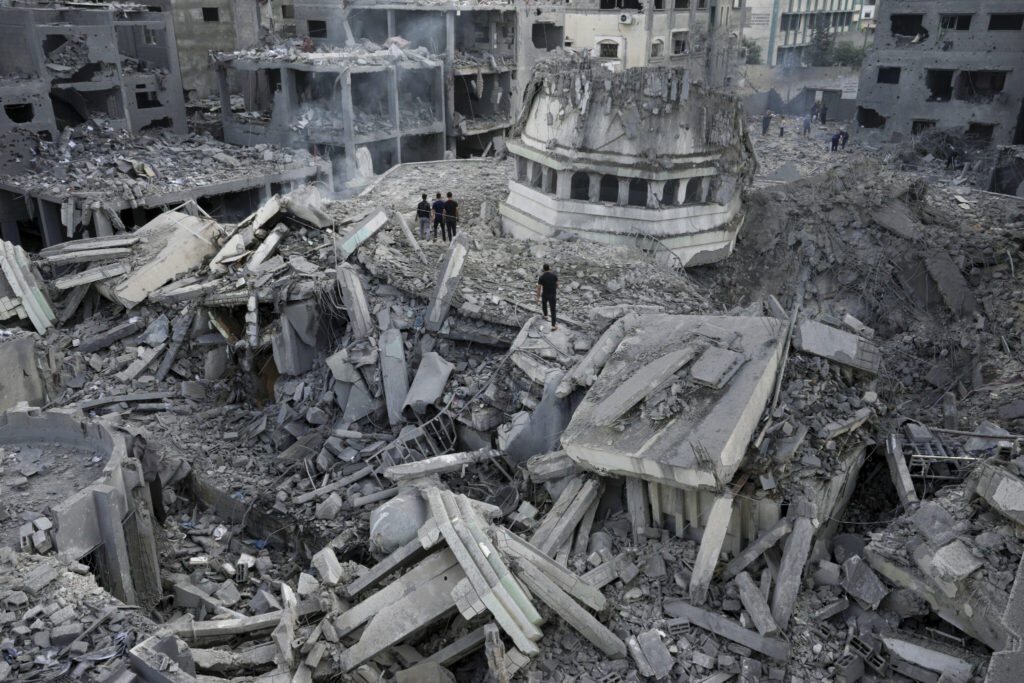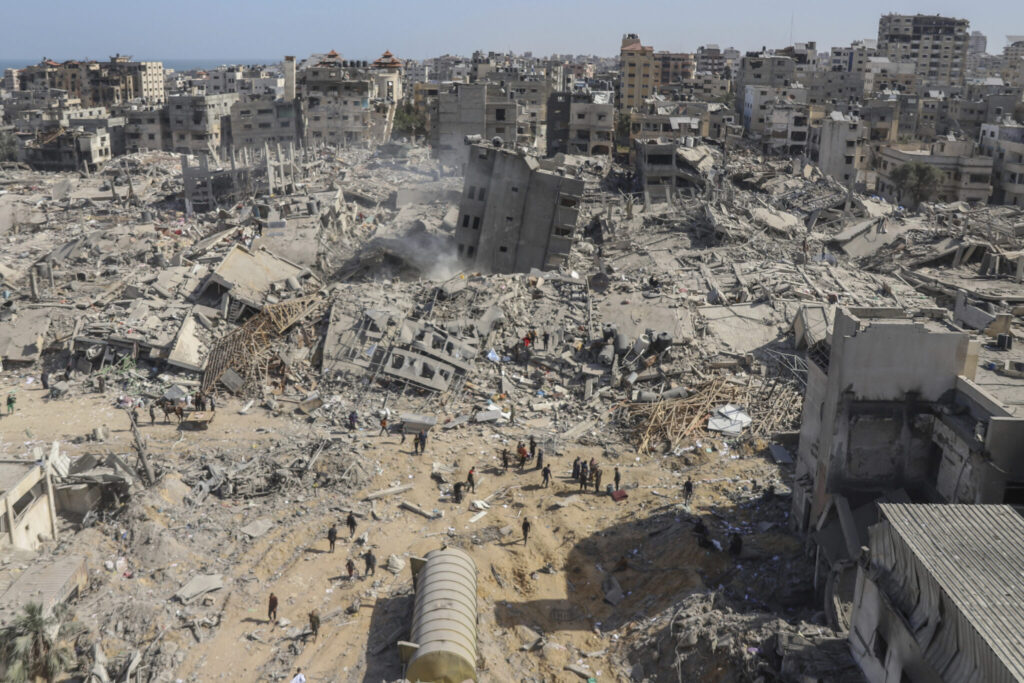Gaza reconstruction/ UN report/ Gaza blockade/ Israel-Hamas conflict/ Gaza economy/ UNCTAD report/ Gaza rebuilding timeline/ Newslooks/ J. Mansour/ Morning Edition/ A new UN report warns that if Gaza remains under blockade, it could take 350 years to rebuild its economy to pre-war levels. The ongoing war has devastated Gaza’s infrastructure, and the reconstruction process faces severe challenges, including the blockade, political unrest, and lack of international funding.

UN Report: Gaza’s Recovery Could Take Centuries Under Blockade – Quick Look
- Gaza may take 350 years to rebuild under current conditions, says UN report.
- The report highlights the destruction caused by Israel’s offensive and ongoing war with Hamas.
- Economic recovery depends on lifting the blockade and major international investment.
- Rebuilding efforts face severe obstacles, including a lack of funding and political barriers.
- Israel maintains that the blockade is necessary to prevent arms smuggling by Hamas.
UN: Gaza May Take 350 Years to Rebuild Under Ongoing Blockade
Deep Look
Gaza’s road to recovery may span centuries if current conditions persist, according to a report released by the U.N. Conference on Trade and Development (UNCTAD) on Monday. The report highlights the severe devastation caused by Israel’s military offensive against Hamas, following the group’s deadly October 7, 2023, attack on Israel. Over a year into the conflict, Gaza remains largely in ruins, and its economy is teetering on the brink of collapse.
The war between Israel and Hamas is one of the most destructive conflicts since World War II. Entire neighborhoods in Gaza have been reduced to rubble, critical infrastructure has been wiped out, and the territory’s economy has been decimated. The report estimates that if the war ended tomorrow and Gaza returned to the status quo before October 2023, it would take an estimated 350 years for the territory’s economy to recover to its pre-war level.
This staggering timeline is based on Gaza’s growth rate from 2007 to 2022, during which it averaged just 0.4% GDP growth annually under the combined impact of Israeli and Egyptian blockades, internal divisions between Hamas and the Palestinian Authority, and previous wars. “If the 2007–2022 growth trend returns, it will take Gaza 350 years just to restore the GDP levels of 2022,” the report states.
Destruction on an Unimaginable Scale
The scale of destruction in Gaza is unprecedented. A U.N. assessment from September 2024 found that nearly a quarter of all structures in the territory had been destroyed or severely damaged, with roughly 66% sustaining some level of damage. More than 227,000 housing units have been affected, and critical infrastructure—including roads, hospitals, schools, and utilities—remains in shambles. Before any serious rebuilding can begin, massive amounts of rubble, unexploded ordnance, and decomposing bodies must be cleared.
The UNCTAD report warns that even if Gaza’s pre-October 2023 economy were restored, it would not provide a path to sustainable development. The territory’s population continues to grow rapidly, and without major reforms and investment, GDP per capita would steadily decline, pushing more people into poverty.
A Blockade That Hinders Recovery
The Israeli-Egyptian blockade, in place since Hamas seized power in Gaza in 2007, is a significant barrier to reconstruction. Israel argues that the blockade is essential to prevent Hamas from smuggling arms into the territory, and blames the militant group for Gaza’s suffering. Israeli Ambassador to the U.N., Danny Danon, responded to the report, stating, “There is no future for the people of Gaza as long as their people continue to be occupied by Hamas.”
The blockade severely restricts the movement of people and goods into Gaza, limiting access to construction materials and other essential supplies. A previous rebuilding mechanism, established after the 2014 war, allowed some reconstruction under heavy Israeli oversight. However, under that system, the Shelter Cluster, an international aid coalition, estimated that it would take 40 years to rebuild Gaza’s housing stock.
Best-Case Scenario Still Decades Away
The UNCTAD report outlines several possible recovery scenarios, but even the most optimistic forecast paints a bleak picture. In a best-case scenario, where the blockade is lifted, movement is unrestricted, and Gaza receives significant international investment, it would still take until 2050 for Gaza’s GDP per capita to return to its 2022 level. Achieving that level of growth would require a 10% annual GDP increase, a tall order given Gaza’s current state.
Meanwhile, a report from the U.N. Development Program (UNDP) released Tuesday predicts that with major investment and the removal of economic restrictions, the broader Palestinian economy—including both Gaza and the West Bank—could stabilize by 2034. However, these scenarios appear increasingly unlikely as the war drags on and Gaza remains under siege.
Challenges Ahead
Israel’s ongoing military campaign in Gaza has caused further devastation, particularly in the northern part of the territory, where entire neighborhoods have been obliterated. With around 90% of Gaza’s 2.3 million residents displaced, hundreds of thousands of people are now living in squalid refugee camps with little access to basic necessities.
International donors have been reluctant to commit to rebuilding Gaza as long as the war continues. Arab Gulf states, including Saudi Arabia and the United Arab Emirates, have said they will only contribute to reconstruction efforts if there is a clear path to a Palestinian state—something that Israeli Prime Minister Benjamin Netanyahu opposes. Netanyahu has repeatedly stated that Israel will maintain long-term security control over Gaza, making the prospect of a complete blockade lift unlikely in the near future.
Adding to the complexity, humanitarian aid into Gaza has been severely restricted. Israel controls all of Gaza’s border crossings and has imposed tight restrictions on the movement of goods and emergency supplies. Ongoing fighting and a breakdown of law and order within the territory have further hampered aid delivery.
The Path Forward
While the call for a cease-fire grows louder, the challenges of rebuilding Gaza remain immense. As Rami Alazzeh, the UNCTAD report’s author, points out, “Everybody now calls for a cease-fire, but people forget that once the cease-fire is done, the 2.2 million Palestinians will wake up having no homes, children having no schools, no universities, no hospitals, no roads.”
Even under the best circumstances, rebuilding Gaza will take decades, and without a political resolution or the lifting of the blockade, it could take far longer. Alazzeh warns that if the current conditions persist, Gaza’s future may be grim: “If we go back to where it was before, and we shouldn’t go back to the way it was before, then I think it means that Gaza’s done.”







